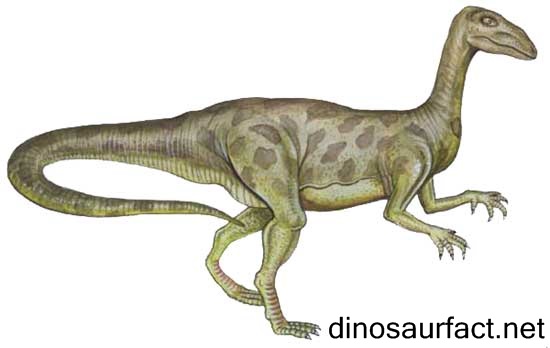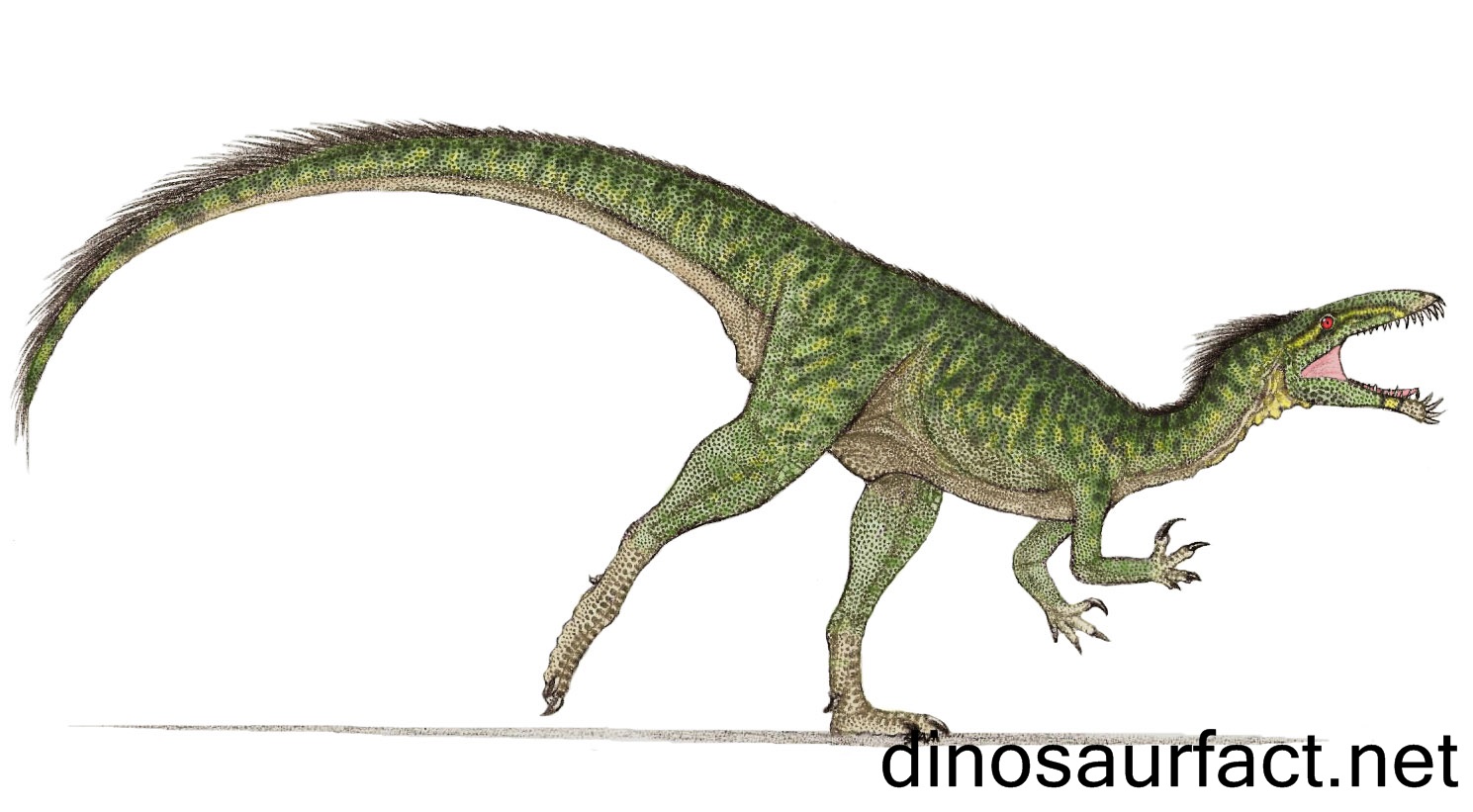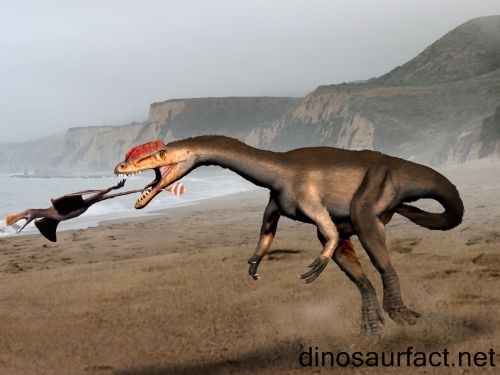 Click to visit the previous dinosaur bio
Click to visit the previous dinosaur bio
 |
|
 |
|
Kingdom: Animalia
Phylum: Chordata
Class: Sauropsida
Superorder: Dinosauria
Order: Saurischia
Suborder: Theropoda
Family: Halticosauridae
Genus: Halticosaurus
 |
|
 |
|
 |
|

The Halticosaurus dinosaur was a coelophysiod from the Norian stage of the Upper Triassic Period. The name Halticosaurus means “nimble lizard”. It lived approximately 208 million years ago in what is known today as Germany.
The Discovery of Fossils
The skeletal remains of the Halticosaurus dinosaur were found in the Middle Stubensandstein formation. It consisted of teeth and partial jaw-bones, back, hip and tail vertebrae, an incomplete neck, an incomplete humerus, fragments of illium and metatarsal and two incomplete femora. The holotype specimen is labeled SMNS 12353. The fossils were intermingled with the fossils of another prosauropod, Sellosaurus gracilis.
The fossils were discovered by A. Burrer, G. Mayer and E. Fraas in 1902 at the Burrerschen Quarry. The fossils were preserved in grayish blue marl. It was named by Friedrich von Huene in 1908. The type species of the Halticosaurus is H. longotarsus. Earlier Huene just classified this genus into Dinosauria but after complete analysis, narrowed it down to the Saurischian family.
Another fossil was found by O. Jaekal in 1909, at the Trossingen Formation, Germany in sediments that date back 208 to 201 million years ago i.e. the Rhaetian Stage.
The SMNS 12353 holotype is currently on exhibit at the State Museum of History, Stuttgart in the Stuttgart province of Germany.
The Norian Stage
The Norian Stage of the upper Triassic is the intermediate stage of the three stages of the Late Triassic period. It lasted from 228 to 208.5 million years ago (mya.). Geochronologically the Norian is an age and chronostratigraphically it is a stage. It is preceded by the Carnian and succeeded by the Rhaetian stage of the Upper Triassic period. The Norian was named after the Austrian Noric Alps, an ancient Roman region that lay to the south of the Danube river.
The Norian stage is further divided into sub stages, namely the Lacian, ALunian, and Sevatian, in ascending order or chronology. Fossil remains of many early dinosaurs that belonged to the Norian stage have been unearthed. These include Synapids, Aetosaurs, Dicynodonts and various phytosaurs.
Stubensandstein Formation and the Discoverers
The Stubensandstein is a geological formation belonging to the Lowenstein area of Baden-Wurttemberg, Germany. The rocks and fossils found in that area date back to the Norian stage. It was an alluvial plain with semi-dry to semi-humid climatic conditions in the Keuper Basin of South Germany.
A variety of fossils have been found from the Stubensandstein including those of Rausuchids like the Teratosaurus, dinosaurs like Efraasia, Plateosaurus and phytosaurs like Nircrosaurus.
Friedrich von Huene was born on March 22, 1875. He is a world-renowned Paleontologist from Germany who is accredited with naming more dinosaurs in the early 20th century than any other European paleontologist. He had an early carnivorous dinosaur, Liassaurus Huenei named in his honor in 1995.
Related dinosaurs and distinguishing characteristics
Researchers considered the Halticosaurus genus to be the same as the Liliensternus, until Samuel Welles found distinguishing characteristics in the anterior trochanter and the femoral head. Scientists have found that the dinosaur bore resemblance to several taxa such as Dilophosaurus and Lilensternus.
The Physical Characteristics and Anatomical details
The hipbone of the dinosaur had two fused sacral vertebrae which is sign of a basal condition. It had five digits on each hand, a primitive condition. The skull was relatively long, measuring up to 18 inches. Despite the long length, the skull was slender in build, with large cavities that helped reduce skull weight. It had strong lower limbs and short arms, suggesting a bipedal structure.
The Halticosaurus dinosaur is measured up to be 5.5 m or eighteen feet long.
An automorphy is defined as “a distinctive feature in a creature or organisms anatomy that is unique to that specific organism or species. Following are the automorphies identified specific to the Halticosaurus:
- The pair of membrane bones of the lower jaw (the dentary) is shallow and pointed towards the anterior end.
- The sacral centra of the dinosaur is narrow.
- There is an additional third sacral vertebra besides the two that were generally present.
- The presence of both tall and short mid cervical vertebrae.
- Small distal condyles are present on the metatarsal and extend not far proximally on the shaft.
- Presence of a sharp ventral keel on the mid cervical vertebrae.
Recent Studies
A second species, the H. orbitoangulataus was discovered and assigned to the genus Halticosaurus. The specimen was labelled SMNS 12353b. It was later found out in 2013 by Hans-Dieter Sues and Rainer R. Schoch that this was, in fact, a basal loricatan.
A third species H. liliensterni was reclassified when Lilienternus was found to be a separate but synonymous group of Halticosaurus.
About the Halticosaurus
The Halticosaurus was a possibly bipedal dinosaur that existed around 208 million years ago. It is a theropod dinosaur. It feasted on the flesh of other creatures i.e. it was a carnivore. It belonged to the family of early coelophysoids. The strong lower limbs of this dinosaur suggest that it was very agile and had the ability to jump up to considerable heights for its size.
The Halticosaurus short arms and 5-fingered hands demonstrate how this creature could grasp its prey for eating. The Halticosaurus species is not known to have lived in groups. It was a fairly territorial animal.
The Halticosaurus has been assigned its own family of Halticosauridae. Efforts have been made to reassign it to Pokodesauridae family. Finally, in 2000, a phylogenetic analysis by Rauhut and Hungerbuhler demonstrated that the Halticosaurus’ classification is indeterminate because the remains are not well-preserved. Despite this, Welles in 1984 has proven that distinguishable morphological differences exist between the Halticosaurus and its sister taxa and other theropod dinosaurs. This enables paleontologists to classify it as a separate taxon by itself.
Even so, much about this creature remains hitherto unknown. More paleontological data can help understand the mechanics of prehistoric life better. Dinosaurs like the Halticosaurus still remain shrouded in mystery, only for want of more fossils. Paleontologists hope to discover more fossils and thus gain more knowledge about the dinosaurs and their way of life.
Index
Extinct Profiles
 Triassic Dinosaurs
Triassic Dinosaurs Jurassic Dinosaurs
Jurassic Dinosaurs Cretaceous Dinosaurs
Cretaceous Dinosaurs Pterosaurs
Pterosaurs Marine Reptiles
Marine Reptiles Dinosaur Extinction
Dinosaur Extinction